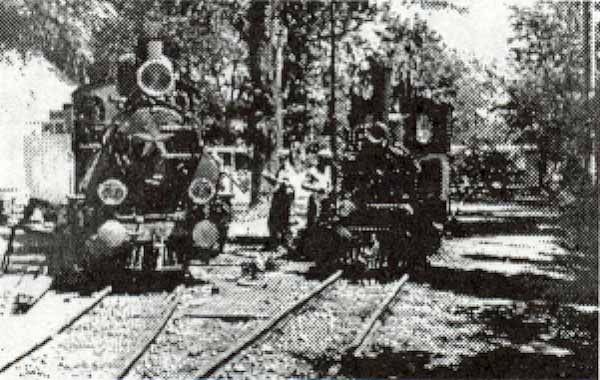
| RUSSIAN |

Children's Railways of the former USSR – Past and Present
Tbilisi Train arrives to Pionerskaya station. foto by M.Kvirikashvili. June 5, 1947. (foto from RGAKFD) archive
Small Transcaucasian Railway
Opened: July 24, 1935 Length: 1.2 km It is located in Mushtaidi Park (formerly: Sergo Ordjnikidse Park) Rolling stock: diesel locomotive Operational season: from March to November Fare for children and adults 0.5 Lari (~0.23 $) On July 24, 1935, the first-ever children's railway in the USSR was opened, in Tifilis. It became the ancestor of a completely new direction in the education and development of schoolboys' technical skills. But it did not appear in a vacuum - in 1933 a group of railway enthusiasts within the children's technical station of Tifilis decided to construct a working breadboard model of a railway. During discussion of the project the interesting idea was born - to choose a scale such that its builders could be placed inside the cab of the steam locomotive and operate it. And it would be possible to carry visitors in little waggons on this line. This idea very quickly took root in the minds of dozens of Tifilisi schoolboys. On December 28, 1933, during thå evening of technical games at the TUS, the heads of the Tiflis Institute of railway transportation (nowadays the Tbilisi Institute of railway transportation engineers) expressed their readiness to help. In the laboratories of the Institute, recruitment of the future builders of the line began. Design work on the road started. Experts from the Institute accepted to participe actively in it. They recommended the choice of a standard track gauge of 750 mm. In those years railways were one of the most dynamic industries, and the whole country observed their development with interest, therefore designing of the Children's Railway was applauded. And the project was ready to start at the beginning of September, 1934 Construction of the line began on September 13, 1934. To prepare the track-bed 7 Komsomolski brigades were organized, each with 30 persons. The works were supervised by G.V.Ahalkadze, then a student in the 4th grade - and subsequently the deputy chief of the Transcaucasian railway. The builders worked completely without payment, on their days off, but this did not cause discontent. Moreover, more and more people wanted to take part in the construction - in the end there were 14 brigades with a total of about 500 persons. Towards the end of the construction process, the question of the search for rolling stock became sharper. It was possible to find a steam locomotive needing repair: Coaches should be built without aid. Coach-parts and coupling were picked up from near at hand, and the open bodies of coaches were made of wood (it should be noted that at that time cars like a "stagecoach", having a roof but no glass windows and with low side walls, were rather widely used on the railways in the southern areas of the country).  The railway was situated in the Sergo Ordjnikidse park (nowadays: Mushtaidi Park). It was quite short: only 1200 meters long, but, apart from the main station In the 1950s there was a project to extend the line along a quay beside the river Kura. The ChRW Collective even constructed a breadboard model of the future line, but this project was not implemented. For some time two steam locomotives were maintained simultaneously on the Tbilisi ChRW - the original The first attempt of converting the line to diesel haulage was undertaken at the end of the 1950s and the beginning of the 1960s, but it was not crowned with success - the diesel locomotive In 1987-88 the line received diesel locomotive
The following material was used in the preparation of this account:
|
The text and/or images on this site may be re-used ONLY if the source URL is clearly quoted.
However, materials marked as "RGAKFD" and "CGAKFFD" must not be re-used without
first obtaining the written consent of the legal owner.
e-mail: railways@postman.ru
